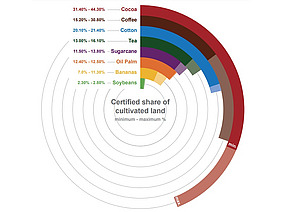Building upon previous editions, the 2024 report presents updated statistics on area, production volume, and the number of producers adhering to 13 major sustainability standards across key commodities, including bananas, cocoa, coffee, cotton, oil palm, soy, sugarcane, tea, and forestry products. The latest data from the standards is from 2022 and highlights both the progress and ongoing challenges in promoting sustainable practices within these sectors.
The report serves as a crucial resource for policymakers, producers, and businesses aiming to address systemic labour and environmental challenges through certified sustainable production. By providing detailed analyses and trends, the report aids stakeholders in making informed decisions to foster a more sustainable and equitable global market.
Trends in certified agricultural land
Almost all agricultural commodities experience growth between 2021 and 2022 and between 2018 and 2022. However, the certified forest area shrunk by 9.7 percent from 2021 to 2022. The drop was due to the suspension of certificates in Russia and Belarus in connection with the war in the region. This shows the impact geopolitical factors can have on sustainable markets.
Once again, cotton, cocoa, oil palm and sugarcane had the largest certified area. Similarly, certified coffee and cocoa still had the largest share of total agricultural land with more than 20 percent of the total coffee and cocoa area certified (see figure).
Dominant sustainability standards
Organic was by far the most dominant sustainability standard in terms of area and product variety, covering more than 96 million hectares or 2 percent of farmland worldwide. Four additional standards covered land exceeding 4 million ha each. Of these, Rainforest Alliance certified the largest area (5.2 million ha), followed by the Roundtable on Sustainable Palm Oil (almost 4.9 million ha), Better Cotton (4.5 million ha) and Global GAP (4.5 million ha), each representing between 0.09 and 0.11 percent of global agricultural land.
Interactive data
In addition to the full report, data and statistics are available online in an interactive format at the ITC’s Standards Map website. Voluntary standards are usually third party-assessed norms and requirements linked to environmental, social, ethical and food safety issues.
The report is funded by the Swiss State Secretariat for Economic Affairs (SECO).
Further information
Contacts
Links
- intracen.org: PDF report "The State of Sustainable Markets. Statistics and Emerging Trends 2024"
- standardsmap.org: Interactive infographics and tables





